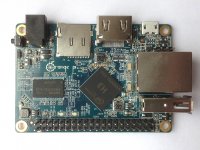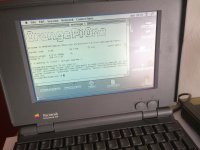mactjaap
Well-known member
A new product of the guys,... uhhh guy... from www.MacIP.net!

The MacIPpi.
This is a dead cheap Orange Pi One ($9.99 and $13.64 with shipping) will act as a macipgw (MacIP gateway) and a Netatalk afpd file server.
It will allow you to surf the Internet with your old Macintosh without any problems. Just connect your old Macintosh with a normal LocalTalk bridge, like an Asante AsanteTalk or a Dayna Etherprint to you LAN and startup you MacIPpi. You can also use an old networking Mac with the LocalTalk Bridge control panel to do the work.
You set your Mac with MacTCP on f.i. 172.16.2.2 (anything between 172.16.2.2 and 254, subnet mask 255.255.255.0), as gateway 172.16.2.1 and DNS 8.8.8.8. Or do the same with a TCP/IP control panle, but then choose Connect via: AppleTalk (MacIP) and configure: Using MacIP manually. Same IP information.
Start a TCP/IP kind of program like, Fetch, Telnet or a browser and of you go to the Internet!
So, what do you you have to do to get this up and running:
- Order a Orange Pi One
- A good Power adapter (5V 2A), or buy it together with your Orange Pi One.
- Take care for a 8GB SD card and maybe a case or buy everything together as a set.
Shipping will take 8 to 14 days.
Download my image from www.macip.net. Use 7zip to unzip.
http://cdn.macip.net/Armbian_5.07_Orangepih3_Debian_jessie_4.6.0-rc1.7z
Use dd on Linux systems (and MacOSX) to put the image on the SD disk.
This will be a command like this:
On a Windows system you can use a tool like Win32DiskImager
Connect you Orange Pi One to the network with a cable. It will get an IP address from your home router if you power it on. After a few minutes it will be ready. Take this time because the appletalk daemon needs some time to settle. Even no need to connect a screen. If you want you can login from your Macintosh with Telnet or SSH. You can use IP address 172.16.2.1 to connect. If you want to connect from a Mac OSX, Windows or Linux machine you have to find out the IP address or use a serial console. If you want to login username is: orangepi and password: orangepi
You can become root by entering
and password orangepi
The system is running Debian strech/sid and kernel 4.6.0



The MacIPpi.
This is a dead cheap Orange Pi One ($9.99 and $13.64 with shipping) will act as a macipgw (MacIP gateway) and a Netatalk afpd file server.
It will allow you to surf the Internet with your old Macintosh without any problems. Just connect your old Macintosh with a normal LocalTalk bridge, like an Asante AsanteTalk or a Dayna Etherprint to you LAN and startup you MacIPpi. You can also use an old networking Mac with the LocalTalk Bridge control panel to do the work.
You set your Mac with MacTCP on f.i. 172.16.2.2 (anything between 172.16.2.2 and 254, subnet mask 255.255.255.0), as gateway 172.16.2.1 and DNS 8.8.8.8. Or do the same with a TCP/IP control panle, but then choose Connect via: AppleTalk (MacIP) and configure: Using MacIP manually. Same IP information.
Start a TCP/IP kind of program like, Fetch, Telnet or a browser and of you go to the Internet!
So, what do you you have to do to get this up and running:
- Order a Orange Pi One
- A good Power adapter (5V 2A), or buy it together with your Orange Pi One.
- Take care for a 8GB SD card and maybe a case or buy everything together as a set.
Shipping will take 8 to 14 days.
Download my image from www.macip.net. Use 7zip to unzip.
http://cdn.macip.net/Armbian_5.07_Orangepih3_Debian_jessie_4.6.0-rc1.7z
Use dd on Linux systems (and MacOSX) to put the image on the SD disk.
This will be a command like this:
Code:
dd if=Armbian_5.07_Orangepih3_Debian_jessie_4.6.0-rc1.raw|pv|dd of=/dev/sdc bs=16MOn a Windows system you can use a tool like Win32DiskImager
Connect you Orange Pi One to the network with a cable. It will get an IP address from your home router if you power it on. After a few minutes it will be ready. Take this time because the appletalk daemon needs some time to settle. Even no need to connect a screen. If you want you can login from your Macintosh with Telnet or SSH. You can use IP address 172.16.2.1 to connect. If you want to connect from a Mac OSX, Windows or Linux machine you have to find out the IP address or use a serial console. If you want to login username is: orangepi and password: orangepi
You can become root by entering
Code:
sudo -iThe system is running Debian strech/sid and kernel 4.6.0


Last edited by a moderator:
